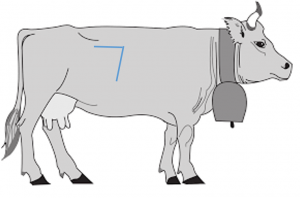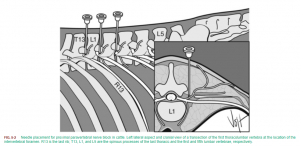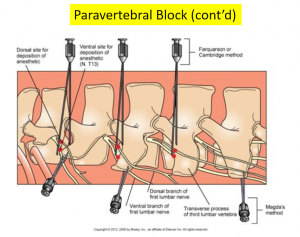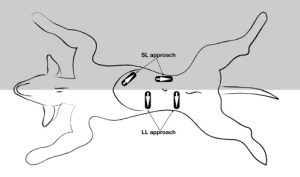General pharmacology
Local anesthesia
We use local blocks very commonly in large animal species. Often bovine standing surgery can be performed without sedation and just with local anesthesia and added analgesics. Epidurals are also relatively easy in dairy cattle and can help with many perineal procedures. More and more horse surgery is being done standing with sedation and local blocks.
Drugs
Lidocaine – Lidocaine is the predominant local anesthetic agent used. Species sensitivity varies with small ruminants and camelids much more sensitive than cattle. Horses are relatively insensitive. The following guidelines are useful to consider as high end doses. Calculate how much you can give and then decide if you need to dilute the drug. Diluted drug still works but has a shorter duration. Hint: 2% lidocaine is 20mg/ml.
| Species | Max dose |
|---|---|
| Cats | 2 mg/kg |
| Sheep and goats | 4-5 mg/kg |
| Camelids | 4-5 mg/kg + |
| Horses | 8 mg/kg |
| Cattle | 8 mg/kg + |
| Swine | 8 mg/kg |
Table listing recommend maximum dosing for lidocaine by species.
The toxic levels pertain until some of the drug is metabolized. Lidocaine’s half life is about 30 minutes. Within 30 minutes, half of what you injected has been metabolized. Within 2.5 hours, you probably have no lidocaine left in the system. This also means your block has worn off well before that 2.5 hour mark.
Mepivacaine lasts longer than lidocaine and can be used for longer procedures if needed. Mepivacaine is commonly used in equine procedures. Bupivacaine can be more tissue toxic and is typically isn’t used except for therapeutic long term blocks (laminitis treatment).
Types of blocks
Nerve blocks: If we know where the nerve is, we can just put local anesthetic near the nerve. Eg dehorning blocks, paravertebral blocks, lameness blocks
Line blocks: Local anesthetic is injected in the line of the planned incision. This does deform the tissue planes but is the easiest to perform; no guessing required.
Field blocks: The nerves to a region are blocked using specific types of line blocks. An L block is used in the flank to block the regional paravertebral nerves.
Ring blocks: A specific type of field block. The entire limb is encircled with subcutaneous local anesthetic to reach any and all nerves
Regional iv blocks: A tourniquet is placed on the limb and local anesthetic injected into a vessel below the tourniquet. The local anesthetic is diluted to the level that it pushes out of the vasculature and into the tissues (typically 20 cc +). This is mock up in a calf using a butterfly catheter (you are supposed to hold the wings up to help direct it).
Rather than threading the vein, go straight in at the “squishy” part – level of the dewclaws, center of the limb. The vessel is very superficial
Sterile block: for “top ups” – eg it didn’t work and now you are scrubbed in and sterile (and have to block her again)
Epidural
The most common epidural agent in food animals is again lidocaine. We typically use 2-8 mg/kg BW, or 5 cc as starting amount in a standard size dairy cow. Lidocaine epidurals can cause ataxia and even recumbency. Lidocaine can be combined with xylazine for longer duration effects with less risk of recumbency; the combination is more common in horses than in cattle. Detomidine can be mixed with lidocaine in horses, as well. In cattle, detomidine leaves the epidural space quickly so more resembles intramuscular detomidine than epidural detomidine. Ketamine and morphine are other options for epidurals.
Lidocaine/xylazine combo – lidocaine 0.22mg/kg + xylazine 0.05 mg/kg, saline added to total volume of 5.7ml
Combination lasts about 300 minutes vs 80 minutes for lidocaine alone
Epidurals are typically performed in the sacrococcygeal space (the most movable space when the tail is pumped up and down). In dairy cattle, a 1.5″ 18 ga needle is inserted in that space at a 45o angle so that the hub is angled toward the tail. A drop of lidocaine is put in the needle hub and should be sucked down into the needle when the epidural space is reached. This is known as the hanging drop technique. It works well in most dairy cattle but isn’t as useful in obese animals.
If the needle is positioned so the bevel is up, the drug will diffuse further forward. If the bevel is pointed down, this will tend to keep the drug in the caudal region.
The needle is this video is way longer than it needs to be but it shows a great hanging drop technique
Flank anesthesia
Flank surgery is common in cattle and requires a good local block. Options include a line block (at the incision site), an inverted L and paravertebral blocks.
Line block
A line block is an injection of subcutaneous lidocaine along the site of the incision. Relatively straightforward, it is often used when nothing else is working. The block can be easier on the animal if a longer needle is used and is inserted through the site of the last injection. This minimizes the number of pokes in unblocked skin. For flank incisions, it is important to also place lidocaine deeper in the muscle layers.
The main disadvantage of a line block is distortion of the surgery field.
Inverted L block
 This block is similar to the line block but is used to block the nerves as they come down the flank and avoids lidocaine directly in the surgery field. The lidocaine is injected in two long lines – one just behind the last rib and one below the transverse processes of the vertebrae. The injection must be deep enough to get the deeper nerves and typically does not block the peritoneum.
This block is similar to the line block but is used to block the nerves as they come down the flank and avoids lidocaine directly in the surgery field. The lidocaine is injected in two long lines – one just behind the last rib and one below the transverse processes of the vertebrae. The injection must be deep enough to get the deeper nerves and typically does not block the peritoneum.
Proximal paravertebral block
For this block, the spinal nerves T13, L1 and L2 are blocked as directly as possible as they exit the spinal cord. This creates a more

effective block. When the block is working, the cow will bend toward the opposite side as muscles are relaxed. The flank will also be warmer due to related vasodilation.
At each site, ~20 ml of lidocaine is injected. Needles are inserted above the transverse processes T13, L1 and L2 and walked off the dorsal margin of each bone. A long needle is used to block the nerve branches both above and below the fascia.
This block can be challenging in very large beef breeds due to difficulty palpating landmarks.
Distal paravertebral block
This block is also aimed at spinal nerves T13, L1 and L2 but is coming at them from a more distal position. As the nerves traverse caudally, the injection sites are at the tips of L1, L2 and L4. At each site, 10-20 ml of lidocaine is injected. As with epidurals, a combination of lidocaine (6 mg/kg) and xylazine (0.02 mg/kg) prolongs the duration of anesthesia as compared to a combination of lidocaine block and intramuscular xylazine injection.

Paravertebral Nerve Block w/captions
Ventral abdomen blocks
For ventral abdominal incisions, you can perform a line block or “U” block with the opening of the U facing the anus. However, the TAP (transversus abdominus plane) block is gaining in popularity and had been shown effective in calves and goats.
TAP (transversus abdominus plane) block
This description is from a study in goats. This block is performed using ultrasound guidance. A 4-12 MHz linear probe is recommended. Bupivicaine is diluted to a 0.25% concentration using sterile saline. Four sites are injected. Each site is injected with about 0.4 ml/kg using a 20 gauge 2.5″ spinal needle. The area is aseptically prepared. The ultrasound probe is positioned immediately caudal to the last rib, midway between the transverse processes of the lumbar vertebrae and the ventral midline. It is held parallel to the long axis of the body. At this level, you should be able to see all three layers of the abdominal wall (external abdominal oblique, internal abdominal oblique and transversus muscles). For the caudal sites, you will see two layers, the rectus abdominus and transversus abdominus.

The needle is passed in a craniocaudal direction. Injection is performed between the internal abdominal oblique and transversus (or between the rectus abdominus and transversus). For the caudal injections, the probe is placed just cranial to the passively flexed stifle at the same level. The injections are repeated on the other side of the body.
Dental blocks
Maxillary nerve block for tooth extraction
Mental nerve blocks
Mental nerve blocks are useful for lower incisor extractions and many rostral jaw or alveolar bone fractures.
The foramen is palpable underneath the depressor labii inferioris muscle (the only muscle in the area). Push this muscle dorsally to palpate the depression. To block the nerve, a 22-gauge 1.5- inch needle is directed into the forarmen, aiming caudally, and 5-8 mls of 2% mepivicane is infused. Using an extension set allows head movement without needle dislodgement. This block desensitizes the rostral mandible and lower lip on the same side as the block.
Resources
Ocular blocks chapter
Perineal blocks chapter
Local, Regional, and Spinal Anesthesia in Ruminants, 2016 VCNA- lots of blocks with good diagrams
Local blocks, Kathy Whitman, Great Plains Education Center (ppt will download)
Comparison of lidocaine and lidocaine-xylazine for distal paravertebral anesthesia in dairy cattle, JAVMA | FEBRUARY 2024 | VOL 262 | NO. 2
Comparison of lidocaine, xylazine, and lidocaine-xylazine for caudal epidural analgesia in cattle. Vet Anaes Analg 2002
Epidural analgesia in cattle, buffalo and camels, 2016 Vet World
Perioperative analgesic effects of an ultrasound-guided transversus abdominis plane block using bupivacaine in goats undergoing celiotomy. Front. Vet. Sci., 24 November 2023
Comparison between two approaches for the transversus abdominis plane block in canine cadavers. Vet Anaesth Analg 2021 Jan;48(1):101-106
Ultrasound-Guided Lateral Transversus Abdominis Plane (TAP)Block in Rabbits: A Cadaveric Study. Animals 2021, 11, 1953.- good ultrasound images

